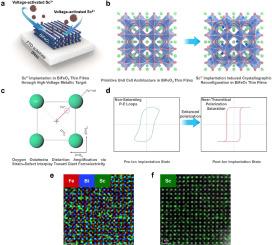Yongshen Lu, Wen Zhang, Ziheng Chen, Fangwang Fu, Jinyong Zhang, Lin Ren, Weimin Wang, Fan Zhang, Zhengyi Fu
求助PDF
{"title":"钪注入BiFeO3中应变-八面体-缺陷的相互作用","authors":"Yongshen Lu, Wen Zhang, Ziheng Chen, Fangwang Fu, Jinyong Zhang, Lin Ren, Weimin Wang, Fan Zhang, Zhengyi Fu","doi":"10.1016/j.jmst.2025.07.076","DOIUrl":null,"url":null,"abstract":"The escalating demand for high-performance nonvolatile memories, driven by the rapid evolution of artificial intelligence hardware, highlights the urgent need for breakthroughs in multiferroic thin-film engineering. While environmentally benign bismuth ferrite (BFO) thin films exhibit intrinsic ferroelectric-ferromagnetic duality, their performance suffers considerable degradation because of dimensional scaling effects and stochastic percolation of oxygen vacancies (<span><span style=\"\"></span><span data-mathml='<math xmlns=\"http://www.w3.org/1998/Math/MathML\"><msubsup is=\"true\"><mi mathvariant=\"normal\" is=\"true\">V</mi><mrow is=\"true\"><mi mathvariant=\"normal\" is=\"true\">O</mi></mrow><mrow is=\"true\"><mo is=\"true\">&#x2022;</mo><mo is=\"true\">&#x2022;</mo></mrow></msubsup></math>' role=\"presentation\" style=\"font-size: 90%; display: inline-block; position: relative;\" tabindex=\"0\"><svg aria-hidden=\"true\" focusable=\"false\" height=\"2.779ex\" role=\"img\" style=\"vertical-align: -1.043ex;\" viewbox=\"0 -747.2 1558.3 1196.3\" width=\"3.619ex\" xmlns:xlink=\"http://www.w3.org/1999/xlink\"><g fill=\"currentColor\" stroke=\"currentColor\" stroke-width=\"0\" transform=\"matrix(1 0 0 -1 0 0)\"><g is=\"true\"><g is=\"true\"><use xlink:href=\"#MJMAIN-56\"></use></g><g is=\"true\" transform=\"translate(750,306)\"><g is=\"true\"><use transform=\"scale(0.707)\" xlink:href=\"#MJMAIN-2219\"></use></g><g is=\"true\" transform=\"translate(353,0)\"><use transform=\"scale(0.707)\" xlink:href=\"#MJMAIN-2219\"></use></g></g><g is=\"true\" transform=\"translate(750,-335)\"><g is=\"true\"><use transform=\"scale(0.707)\" xlink:href=\"#MJMAIN-4F\"></use></g></g></g></g></svg><span role=\"presentation\"><math xmlns=\"http://www.w3.org/1998/Math/MathML\"><msubsup is=\"true\"><mi is=\"true\" mathvariant=\"normal\">V</mi><mrow is=\"true\"><mi is=\"true\" mathvariant=\"normal\">O</mi></mrow><mrow is=\"true\"><mo is=\"true\">•</mo><mo is=\"true\">•</mo></mrow></msubsup></math></span></span><script type=\"math/mml\"><math><msubsup is=\"true\"><mi mathvariant=\"normal\" is=\"true\">V</mi><mrow is=\"true\"><mi mathvariant=\"normal\" is=\"true\">O</mi></mrow><mrow is=\"true\"><mo is=\"true\">•</mo><mo is=\"true\">•</mo></mrow></msubsup></math></script></span>). Herein, we introduce a quantum-engineered implantation strategy utilizing scandium ions (Sc<sup>3+</sup>) as metastable interstitial dopants to systematically establish self-adaptive lattice-oxygen vacancy equilibria through quantum-confined interactions. Atomic-resolution electron microscopy and multiferroicity scaling behavior analysis reveal that precise Sc<sup>3+</sup> implantation (dose: 10<sup>15</sup> ions·cm<sup>−2</sup>) induces a quantum-confined strain field and vacancy dipole ordering, synergistically enhancing ferroelectric polarization to 158.6 μC/cm<sup>2</sup> while suppressing leakage currents to 10⁻<sup>8</sup> A/cm². Concurrently, strain-mediated magnetoelectric coupling elevates saturation magnetization to 0.82 emu/cm<sup>3</sup> via the modulation of the spin–lattice interaction, accompanied by electronic structure reconfiguration (bandgap narrowing Δ<em>E</em><sub>g</sub> = 2.09 eV). Crucially, Sc<sup>3+</sup>–<span><span style=\"\"></span><span data-mathml='<math xmlns=\"http://www.w3.org/1998/Math/MathML\"><msubsup is=\"true\"><mi mathvariant=\"normal\" is=\"true\">V</mi><mrow is=\"true\"><mi mathvariant=\"normal\" is=\"true\">O</mi></mrow><mrow is=\"true\"><mo is=\"true\">&#x2022;</mo><mo is=\"true\">&#x2022;</mo></mrow></msubsup></math>' role=\"presentation\" style=\"font-size: 90%; display: inline-block; position: relative;\" tabindex=\"0\"><svg aria-hidden=\"true\" focusable=\"false\" height=\"2.779ex\" role=\"img\" style=\"vertical-align: -1.043ex;\" viewbox=\"0 -747.2 1558.3 1196.3\" width=\"3.619ex\" xmlns:xlink=\"http://www.w3.org/1999/xlink\"><g fill=\"currentColor\" stroke=\"currentColor\" stroke-width=\"0\" transform=\"matrix(1 0 0 -1 0 0)\"><g is=\"true\"><g is=\"true\"><use xlink:href=\"#MJMAIN-56\"></use></g><g is=\"true\" transform=\"translate(750,306)\"><g is=\"true\"><use transform=\"scale(0.707)\" xlink:href=\"#MJMAIN-2219\"></use></g><g is=\"true\" transform=\"translate(353,0)\"><use transform=\"scale(0.707)\" xlink:href=\"#MJMAIN-2219\"></use></g></g><g is=\"true\" transform=\"translate(750,-335)\"><g is=\"true\"><use transform=\"scale(0.707)\" xlink:href=\"#MJMAIN-4F\"></use></g></g></g></g></svg><span role=\"presentation\"><math xmlns=\"http://www.w3.org/1998/Math/MathML\"><msubsup is=\"true\"><mi is=\"true\" mathvariant=\"normal\">V</mi><mrow is=\"true\"><mi is=\"true\" mathvariant=\"normal\">O</mi></mrow><mrow is=\"true\"><mo is=\"true\">•</mo><mo is=\"true\">•</mo></mrow></msubsup></math></span></span><script type=\"math/mml\"><math><msubsup is=\"true\"><mi mathvariant=\"normal\" is=\"true\">V</mi><mrow is=\"true\"><mi mathvariant=\"normal\" is=\"true\">O</mi></mrow><mrow is=\"true\"><mo is=\"true\">•</mo><mo is=\"true\">•</mo></mrow></msubsup></math></script></span> pairs exhibit policy network-like characteristics, wherein each dopant autonomously optimizes local multiferroic responses through strain-oxygen chemical potential feedback loops. This study provides a Materials Genome blueprint for the design of multiferroic systems, bridging the gap between quantum-scale manipulation and device-level operational stability in oxide electronics.","PeriodicalId":16154,"journal":{"name":"Journal of Materials Science & Technology","volume":"42 1","pages":""},"PeriodicalIF":14.3000,"publicationDate":"2025-09-27","publicationTypes":"Journal Article","fieldsOfStudy":null,"isOpenAccess":false,"openAccessPdf":"","citationCount":"0","resultStr":"{\"title\":\"Tailored strain–octahedral–defect interplay for giant multiferroicity in BiFeO3 via scandium implantation\",\"authors\":\"Yongshen Lu, Wen Zhang, Ziheng Chen, Fangwang Fu, Jinyong Zhang, Lin Ren, Weimin Wang, Fan Zhang, Zhengyi Fu\",\"doi\":\"10.1016/j.jmst.2025.07.076\",\"DOIUrl\":null,\"url\":null,\"abstract\":\"The escalating demand for high-performance nonvolatile memories, driven by the rapid evolution of artificial intelligence hardware, highlights the urgent need for breakthroughs in multiferroic thin-film engineering. While environmentally benign bismuth ferrite (BFO) thin films exhibit intrinsic ferroelectric-ferromagnetic duality, their performance suffers considerable degradation because of dimensional scaling effects and stochastic percolation of oxygen vacancies (<span><span style=\\\"\\\"></span><span data-mathml='<math xmlns=\\\"http://www.w3.org/1998/Math/MathML\\\"><msubsup is=\\\"true\\\"><mi mathvariant=\\\"normal\\\" is=\\\"true\\\">V</mi><mrow is=\\\"true\\\"><mi mathvariant=\\\"normal\\\" is=\\\"true\\\">O</mi></mrow><mrow is=\\\"true\\\"><mo is=\\\"true\\\">&#x2022;</mo><mo is=\\\"true\\\">&#x2022;</mo></mrow></msubsup></math>' role=\\\"presentation\\\" style=\\\"font-size: 90%; display: inline-block; position: relative;\\\" tabindex=\\\"0\\\"><svg aria-hidden=\\\"true\\\" focusable=\\\"false\\\" height=\\\"2.779ex\\\" role=\\\"img\\\" style=\\\"vertical-align: -1.043ex;\\\" viewbox=\\\"0 -747.2 1558.3 1196.3\\\" width=\\\"3.619ex\\\" xmlns:xlink=\\\"http://www.w3.org/1999/xlink\\\"><g fill=\\\"currentColor\\\" stroke=\\\"currentColor\\\" stroke-width=\\\"0\\\" transform=\\\"matrix(1 0 0 -1 0 0)\\\"><g is=\\\"true\\\"><g is=\\\"true\\\"><use xlink:href=\\\"#MJMAIN-56\\\"></use></g><g is=\\\"true\\\" transform=\\\"translate(750,306)\\\"><g is=\\\"true\\\"><use transform=\\\"scale(0.707)\\\" xlink:href=\\\"#MJMAIN-2219\\\"></use></g><g is=\\\"true\\\" transform=\\\"translate(353,0)\\\"><use transform=\\\"scale(0.707)\\\" xlink:href=\\\"#MJMAIN-2219\\\"></use></g></g><g is=\\\"true\\\" transform=\\\"translate(750,-335)\\\"><g is=\\\"true\\\"><use transform=\\\"scale(0.707)\\\" xlink:href=\\\"#MJMAIN-4F\\\"></use></g></g></g></g></svg><span role=\\\"presentation\\\"><math xmlns=\\\"http://www.w3.org/1998/Math/MathML\\\"><msubsup is=\\\"true\\\"><mi is=\\\"true\\\" mathvariant=\\\"normal\\\">V</mi><mrow is=\\\"true\\\"><mi is=\\\"true\\\" mathvariant=\\\"normal\\\">O</mi></mrow><mrow is=\\\"true\\\"><mo is=\\\"true\\\">•</mo><mo is=\\\"true\\\">•</mo></mrow></msubsup></math></span></span><script type=\\\"math/mml\\\"><math><msubsup is=\\\"true\\\"><mi mathvariant=\\\"normal\\\" is=\\\"true\\\">V</mi><mrow is=\\\"true\\\"><mi mathvariant=\\\"normal\\\" is=\\\"true\\\">O</mi></mrow><mrow is=\\\"true\\\"><mo is=\\\"true\\\">•</mo><mo is=\\\"true\\\">•</mo></mrow></msubsup></math></script></span>). Herein, we introduce a quantum-engineered implantation strategy utilizing scandium ions (Sc<sup>3+</sup>) as metastable interstitial dopants to systematically establish self-adaptive lattice-oxygen vacancy equilibria through quantum-confined interactions. Atomic-resolution electron microscopy and multiferroicity scaling behavior analysis reveal that precise Sc<sup>3+</sup> implantation (dose: 10<sup>15</sup> ions·cm<sup>−2</sup>) induces a quantum-confined strain field and vacancy dipole ordering, synergistically enhancing ferroelectric polarization to 158.6 μC/cm<sup>2</sup> while suppressing leakage currents to 10⁻<sup>8</sup> A/cm². Concurrently, strain-mediated magnetoelectric coupling elevates saturation magnetization to 0.82 emu/cm<sup>3</sup> via the modulation of the spin–lattice interaction, accompanied by electronic structure reconfiguration (bandgap narrowing Δ<em>E</em><sub>g</sub> = 2.09 eV). Crucially, Sc<sup>3+</sup>–<span><span style=\\\"\\\"></span><span data-mathml='<math xmlns=\\\"http://www.w3.org/1998/Math/MathML\\\"><msubsup is=\\\"true\\\"><mi mathvariant=\\\"normal\\\" is=\\\"true\\\">V</mi><mrow is=\\\"true\\\"><mi mathvariant=\\\"normal\\\" is=\\\"true\\\">O</mi></mrow><mrow is=\\\"true\\\"><mo is=\\\"true\\\">&#x2022;</mo><mo is=\\\"true\\\">&#x2022;</mo></mrow></msubsup></math>' role=\\\"presentation\\\" style=\\\"font-size: 90%; display: inline-block; position: relative;\\\" tabindex=\\\"0\\\"><svg aria-hidden=\\\"true\\\" focusable=\\\"false\\\" height=\\\"2.779ex\\\" role=\\\"img\\\" style=\\\"vertical-align: -1.043ex;\\\" viewbox=\\\"0 -747.2 1558.3 1196.3\\\" width=\\\"3.619ex\\\" xmlns:xlink=\\\"http://www.w3.org/1999/xlink\\\"><g fill=\\\"currentColor\\\" stroke=\\\"currentColor\\\" stroke-width=\\\"0\\\" transform=\\\"matrix(1 0 0 -1 0 0)\\\"><g is=\\\"true\\\"><g is=\\\"true\\\"><use xlink:href=\\\"#MJMAIN-56\\\"></use></g><g is=\\\"true\\\" transform=\\\"translate(750,306)\\\"><g is=\\\"true\\\"><use transform=\\\"scale(0.707)\\\" xlink:href=\\\"#MJMAIN-2219\\\"></use></g><g is=\\\"true\\\" transform=\\\"translate(353,0)\\\"><use transform=\\\"scale(0.707)\\\" xlink:href=\\\"#MJMAIN-2219\\\"></use></g></g><g is=\\\"true\\\" transform=\\\"translate(750,-335)\\\"><g is=\\\"true\\\"><use transform=\\\"scale(0.707)\\\" xlink:href=\\\"#MJMAIN-4F\\\"></use></g></g></g></g></svg><span role=\\\"presentation\\\"><math xmlns=\\\"http://www.w3.org/1998/Math/MathML\\\"><msubsup is=\\\"true\\\"><mi is=\\\"true\\\" mathvariant=\\\"normal\\\">V</mi><mrow is=\\\"true\\\"><mi is=\\\"true\\\" mathvariant=\\\"normal\\\">O</mi></mrow><mrow is=\\\"true\\\"><mo is=\\\"true\\\">•</mo><mo is=\\\"true\\\">•</mo></mrow></msubsup></math></span></span><script type=\\\"math/mml\\\"><math><msubsup is=\\\"true\\\"><mi mathvariant=\\\"normal\\\" is=\\\"true\\\">V</mi><mrow is=\\\"true\\\"><mi mathvariant=\\\"normal\\\" is=\\\"true\\\">O</mi></mrow><mrow is=\\\"true\\\"><mo is=\\\"true\\\">•</mo><mo is=\\\"true\\\">•</mo></mrow></msubsup></math></script></span> pairs exhibit policy network-like characteristics, wherein each dopant autonomously optimizes local multiferroic responses through strain-oxygen chemical potential feedback loops. This study provides a Materials Genome blueprint for the design of multiferroic systems, bridging the gap between quantum-scale manipulation and device-level operational stability in oxide electronics.\",\"PeriodicalId\":16154,\"journal\":{\"name\":\"Journal of Materials Science & Technology\",\"volume\":\"42 1\",\"pages\":\"\"},\"PeriodicalIF\":14.3000,\"publicationDate\":\"2025-09-27\",\"publicationTypes\":\"Journal Article\",\"fieldsOfStudy\":null,\"isOpenAccess\":false,\"openAccessPdf\":\"\",\"citationCount\":\"0\",\"resultStr\":null,\"platform\":\"Semanticscholar\",\"paperid\":null,\"PeriodicalName\":\"Journal of Materials Science & Technology\",\"FirstCategoryId\":\"88\",\"ListUrlMain\":\"https://doi.org/10.1016/j.jmst.2025.07.076\",\"RegionNum\":1,\"RegionCategory\":\"材料科学\",\"ArticlePicture\":[],\"TitleCN\":null,\"AbstractTextCN\":null,\"PMCID\":null,\"EPubDate\":\"\",\"PubModel\":\"\",\"JCR\":\"Q1\",\"JCRName\":\"MATERIALS SCIENCE, MULTIDISCIPLINARY\",\"Score\":null,\"Total\":0}","platform":"Semanticscholar","paperid":null,"PeriodicalName":"Journal of Materials Science & Technology","FirstCategoryId":"88","ListUrlMain":"https://doi.org/10.1016/j.jmst.2025.07.076","RegionNum":1,"RegionCategory":"材料科学","ArticlePicture":[],"TitleCN":null,"AbstractTextCN":null,"PMCID":null,"EPubDate":"","PubModel":"","JCR":"Q1","JCRName":"MATERIALS SCIENCE, MULTIDISCIPLINARY","Score":null,"Total":0}
引用次数: 0
引用
批量引用


 求助内容:
求助内容: 应助结果提醒方式:
应助结果提醒方式:


